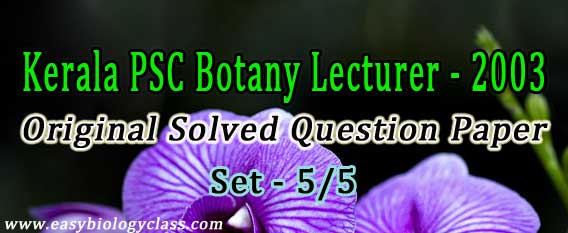Kerala PSC Botany Lecturer / Assistant Professor Original Solved Question Paper: 2003 Exam
(Question Paper Code: 250/2003)
Original solved question paper of Kerala PSC Botany Lecturer/Assistant Professor examination conducted by Kerala PSC (Kerala Public Service Commission) for the recruitment / appointment of Botany Lecturer/Assistant Professor in Government Colleges of Kerala under the Directorate of Collegiate Education, Trivandrum, Kerala. The test was conducted in the year 2003 and the Question Paper Code Number is 250/2003. All questions were in MCQ (Multiple Choice Questions) format. A detailed answer key with explanations is given at end of each set.
Part – 5/5 (Questions 81 – 100)
81. Androecium forms a column of five united stamens in:
a. Cyclanthera
b. Cucurbita
c. Luffa
d. Lagenaria
82. Druses are:
a. Newly formed structures in the periderm after secondary thickening
b. A food reserve developed in older part of the stem
c. Cytoplasmic living inclusion without any definite function
d. A globular calcium oxalate crystal formed in some plants
83. Callus formation from a leaf explant is due to:
a. Cyto-differentiation
b. De-differentiation
c. Re-differentiation
d. Tissue disorganization
84. Interrupted mating technique is used in bacteria for:
a. Increase fertility rate
b. To study transformations
c. To produce desirable strains
d. Mapping of bacterial genes
85. Technique for identification of DNA sites for a specific protein is:
a. DNA fingerprinting
b. DNA amplification
c. DNA footprinting
d. DNA sequencing
86. Which of the following is not an asexual reproductive structure in lichens?
a. Soredia
b. Isidia
c. Aecidia
d. Cephaloidia
87. Increasing the concentration of lipophilic chlorinated hydrocarbon in the biological system is due to
a. Biomagnification
b. Bioformation
c. Biodegradation
d. Bioprocessing
88. Hormogone formation is a method of vegetative reproduction in:
a. Penicillium
b. E. coli
c. Oscillatoria
d. Cladonia
89. Standard redox potential is:
a. Redox potential when reactants are in equal quantity
b. Concentration of oxidant and reductant are equal at normal pH
c. Redox potential equal to that of the standard chemical
d. Reaction ability of two chemical at a higher pH
90. Chlorosomes are pigments with proteinaceous covering present in:
a. Chlorophyllated cells
b. Green coloured reserve food
c. Green pigments of algal cells
d. Photosynthetic bacteria
91. Red rot of sugarcane is caused by:
a. Cercospora personatua
b. Puccinia graminis
c. Colletotrichum falcatum
d. Alternaria tenuis
92. Coal balls are:
a. Petrified spherical plant remaining
b. Purified coal occurs as a big deposit
c. Dead and non-decayed organism deposits
d. Unreacted calcium carbonate deposits
93. Fossil Bryophytes recorded from Paleozoic era is:
a. Polytrichum
b. Ricciocarpus
c. Sporogonites
d. Cryptothalus
94. Vascular structure of Lepidodendron is:
a. Plectostelic
b. Dictyostelic
c. Siphonostelic
d. Protostelic
95. Radio dating is done to:
a. Estimate the level of radiation
b. Estimate the energy content of radiation
c. Estimate the age of rocks and fossils
d. Evaluate the dosage of hazardous radiation
96. The fossil taxa related to Magnoliales
a. Cycadeoidea
b. Degeneria
c. Caytonia
d. Sassyfrastus
97. Leff-handed zigzag double helical DNA model is:
a. Sasisekharan’s model
b. Z-model
c. Watson and Crick’s model
d. Wilkin’s model
98. Raphanobrassica is an example of:
a. Autopolyploid
b. Polyhaploid
c. Allopolyploid
d. Autoaneuploid
99. Transferring elements which carry genetic element of DNA segment is called:
a. Transposons
b. Transferring elements
c. Transfer RNA
d. Retro elements
100. ‘Klinefelters’ syndrome is due to the genotype:
a. XY male
b. XXY male
c. ZO male
d. XO male
Kerala PSC Botany Lecture Exam 2003 Question Paper
| Part – 1/5 | Part – 2/5 | Part – 3/5 | Part – 4/5 | Part – 5/5 |
Answer Key (Kerala PSC Botany Lecturer Exam 2003) Part 3/5
The answer key is prepared with best of my knowledge and all of them may not be correct. If you find any mistakes in my decision, you should point it out and it will be appreciated. Contact: Admin.
81. Ans. (b). Cucurbita
82. Ans. (d). A globular calcium oxalate crystal formed in some plants
83. Ans. (b). Dedifferentiation
84. Ans. (d). Mapping of bacterial genes
85. Ans. (c). DNA footprinting
86. Ans. (d). Cephaloidia
87. Ans. (a). Biomagnification
88. Ans. (c). Oscillatoria
89. Ans. I do not know the answer, please inform me if you know
90. Ans. (d). Photosynthetic bacteria
91. Ans. (c). Colletotrichum falcatum
92. Ans. (a). Petrified spherical plant remaining
93. Ans. (c). Sporogonites
94. Ans. (c). Siphonostelic
95. Ans. (c). Estimate the age of rocks and fossils
96. Ans. (b). Degeneria
97. Ans. (b). Z-model
98. Ans. (c). Allopolyploid
99. Ans. (a). Transposons
100. Ans. (b). XXY male
